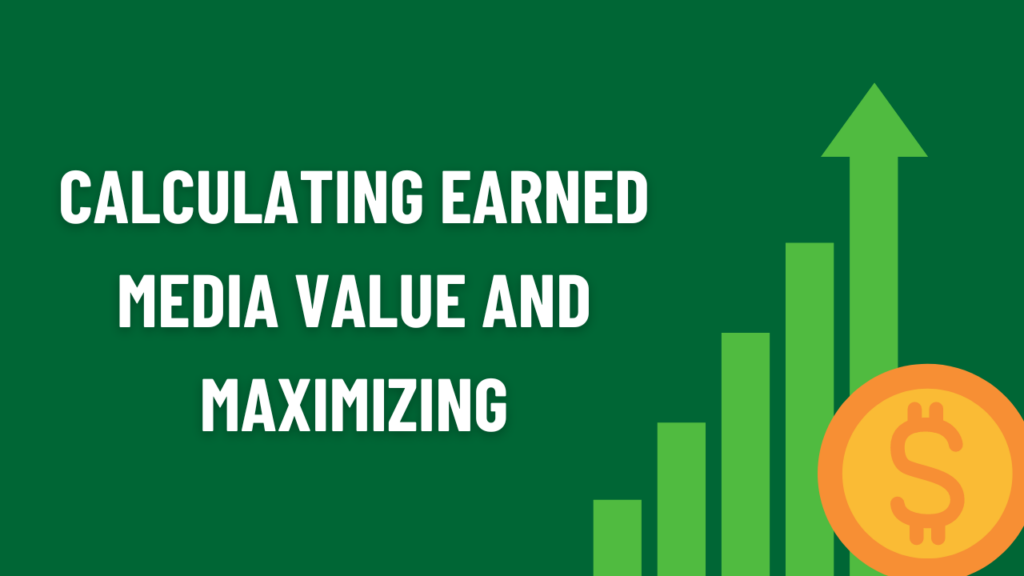Calculating earned media value is indeed a complex endeavor, given the multitude of variables at play. Unlike owned or paid media, which offer relatively controlled environments for messaging and measurement, earned media operates within a landscape shaped by external factors such as audience sentiment, influencer dynamics, and viral potential. Quantifying the impact of earned media necessitates grappling with diverse metrics ranging from social shares and mentions to sentiment analysis and brand sentiment shifts.
Moreover, the credibility and reach of earned media can fluctuate unpredictably, making it challenging to attribute specific outcomes solely to earned efforts. Factor in the ever-evolving digital ecosystem with its myriad platforms and channels, and the task becomes even more daunting. Thus, while the advent of analytics tools and data tracking has enhanced our ability to gauge earned media value, accurately calculating its true impact remains an intricate puzzle requiring constant refinement and adaptation.
We have written a comprehensive post on Earned Media Value. Do read it here
Definition of Earned Media Value
Earned Media Value (EMV) is a measure used by businesses to calculate the worth of their non-paid media presence. These can include social mentions, shares, re-tweets, blog posts, news features, and any other form of media attention that has not been directly paid for. EMV is crucial for businesses as it quantifies the impact of organic or unpaid marketing strategies in monetary terms.
Importance of Earned Media Value in Management
The significance of Earned Media Value in management cannot be overstated. It enables businesses to quantify the efficacy of their marketing strategies and helps them gauge their brand visibility. A higher EMV indicates greater brand recognition and a more extensive reach. Such value measurement can be instrumental in decision-making processes, allowing managers to allocate resources effectively, strategize marketing efforts, and assess their return on investment (ROI) on their marketing expenditure.
Unraveling the Concept of Earned Media Value
Differences between Earned, Owned, and Paid Media
Earned Media: This refers to publicity gained through promotional efforts other than advertising, such as word-of-mouth, buzz, reviews, news coverage, comments, feedback, likes, shares, and mentions. It consists of unpaid recognition and can be considered as the most credible form of advertising. The key point about earned media is that it is unsolicited, meaning that it is freely given by consumers, critics, or the public.
Owned Media: This consists of properties or channels that are fully controlled by the company or organization itself, including the company’s website, blogs, social media profiles, newsletters, whitepapers, and more. The key benefit of owned media is control over the message and the ability to modify it as needed.
Paid Media: This involves the company or organization paying to leverage a third-party channel, such as display ads, sponsored posts, promotional content, pay-per-click (PPC), and other types of advertising. The advantage of paid media is the immediate visibility and scale that it provides.
| Aspect | Earned Media | Owned Media | Paid Media |
| Definition | Publicity gained through word-of-mouth, referrals, media coverage, viral content, etc. | Channels controlled by the brand, such as websites, blogs, social media profiles, etc. | Advertising space bought to promote content, products, or services |
| Source | External sources (not directly controlled by the brand) | Controlled directly by the brand | Purchased from third-party platforms or publishers |
| Cost | Typically no direct cost, but efforts are needed to generate buzz or publicity | Costs associated with creation, maintenance, and promotion are borne by the brand | Requires budget allocation for ad placements, bidding, etc. |
| Credibility | Higher credibility due to third-party endorsement | Moderate credibility, seen as biased by some audiences | Lower credibility due to obvious promotional nature |
| Control | Little to no control over the message or distribution | Full control over content, message, and distribution | Complete control over content, targeting, and placement |
| Examples | Social media mentions, reviews, press coverage, viral content | Brand website, blog posts, social media profiles, newsletters | Display ads, sponsored content, PPC advertising, influencer partnerships |
Factors Influencing Earned Media Value
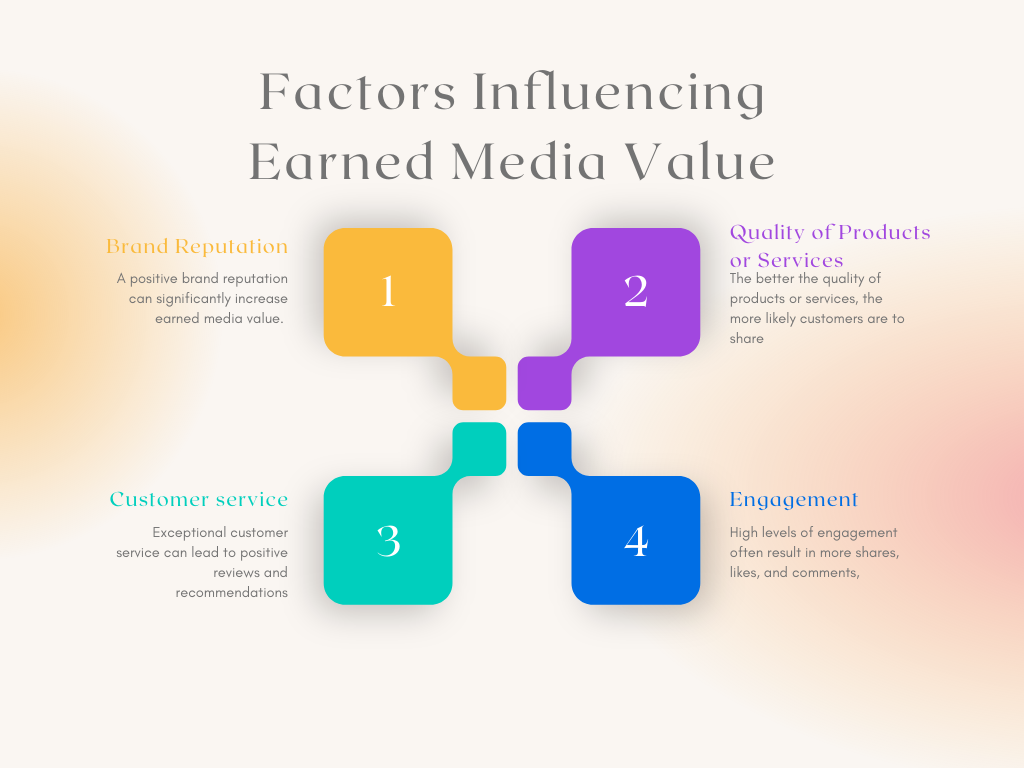
Brand Reputation: A positive brand reputation can significantly increase earned media value. Firms with strong goodwill often receive more free press and consumer advocacy.
Quality of Products or Services: The better the quality of products or services, the more likely customers are to share their positive experiences, thus increasing earned media value.
Customer service: Exceptional customer service can lead to positive reviews and recommendations, enhancing earned media value.
Engagement: High levels of engagement often result in more shares, likes, and comments, which can increase earned media value.
Role of Earned Media Value in Modern Business
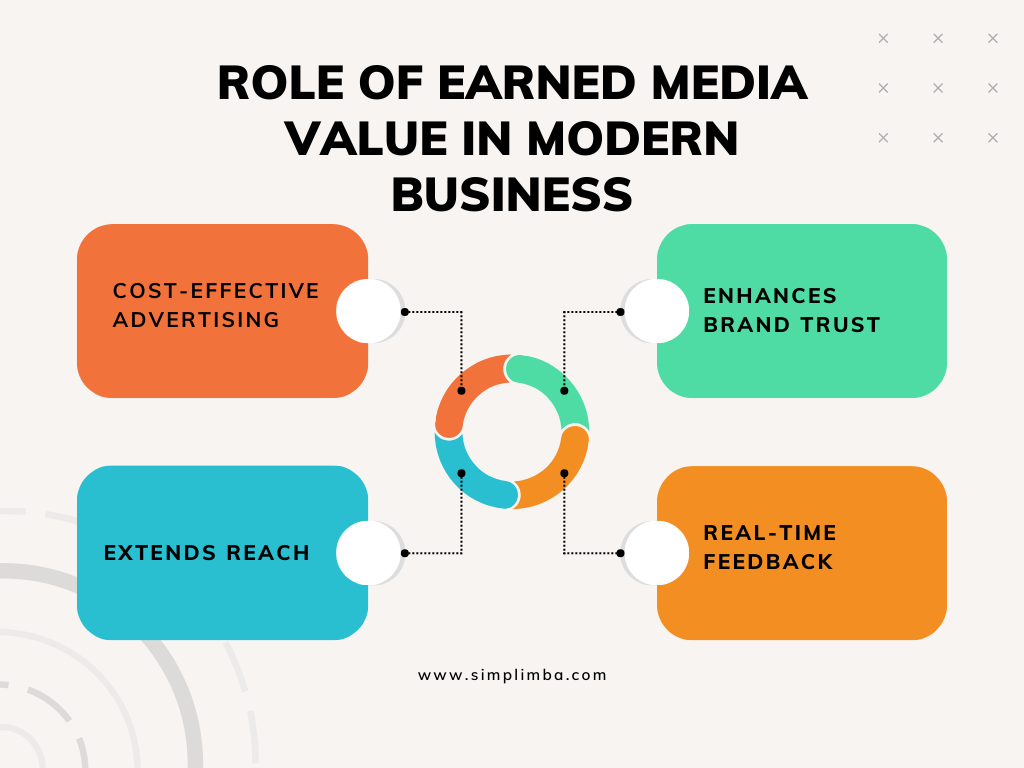
Cost-Effective Advertising: Earned media value can provide cost-effective advertising for businesses, as it requires fewer resources than traditional paid media.
Enhances Brand Trust: As earned media is unsolicited, it is perceived as more trustworthy by consumers, which can enhance brand trust and loyalty.
Extends Reach: Earned media can extend a business’s reach beyond its usual audience, as shares, likes, and comments can expose the brand to new potential customers.
Real-Time Feedback: Earned media provides businesses with real-time feedback, enabling them to understand what their customers think and feel about their offerings, and adjust their strategies accordingly.
Formula to Calculate Earned Media Value
To calculate earned media value, one can use the formula: EMV = (Number of mentions x Average value per mention) + (Number of shares x Average value per share) + (Number of likes x Average value per like). This formula takes into account the various aspects of user interaction and assigns them a monetary value.
Understanding Key Metrics in Calculating Earned Media Value
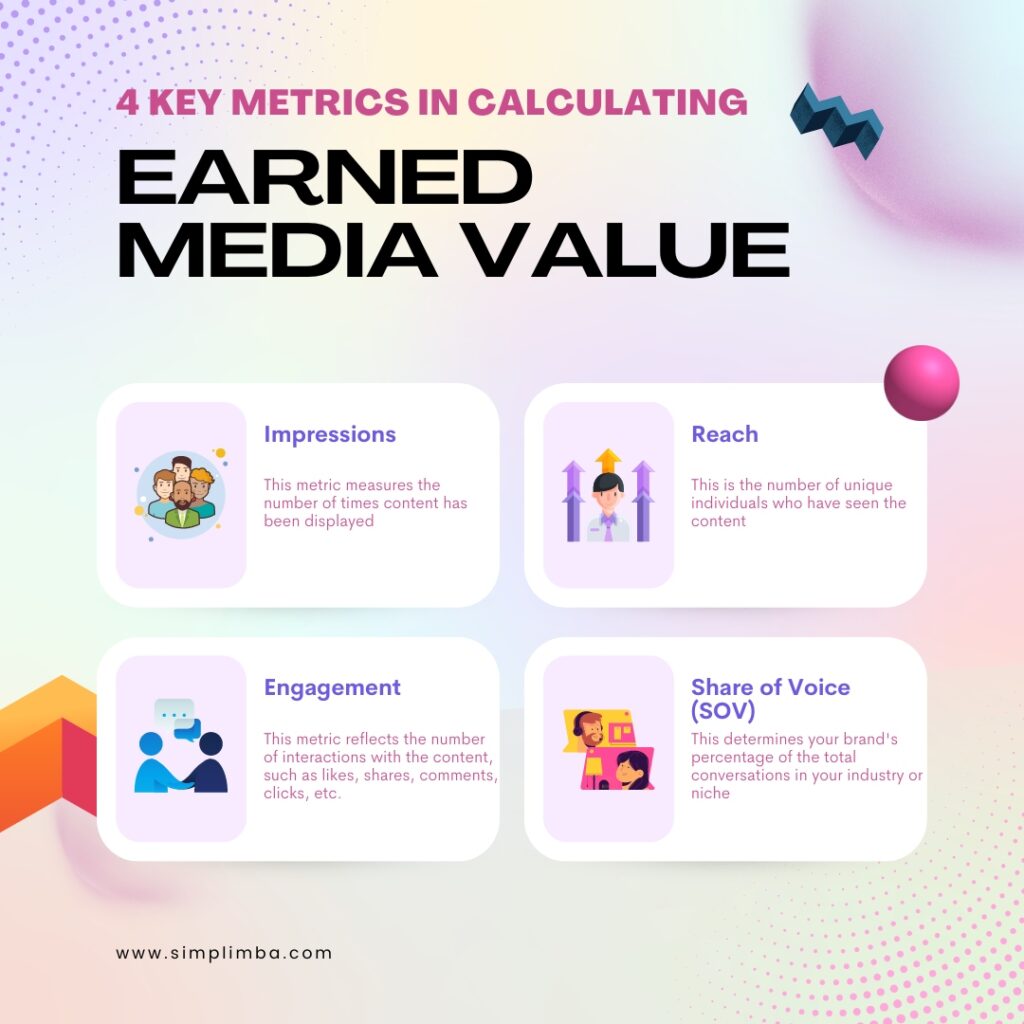
When it comes to calculating earned media value, several key metrics play a very crucial role. These metrics form the basis for a precise calculation, which aids in understanding the true value of earned media.
Impressions: This metric measures the number of times content has been displayed. It provides the total potential views of a particular piece of content and is not exclusive to unique viewers.
Reach: This is the number of unique individuals who have seen the content. Unlike impressions, reach takes into account only unique views thus reducing the risk of estimation inflation.
Engagement: This metric reflects the number of interactions with the content, such as likes, shares, comments, clicks, etc. It gauges audience response and involvement with the content.
Share of Voice (SOV): This determines your brand’s percentage of the total conversations in your industry or niche. It’s a way to measure brand popularity and relevance in the market.
Essential Steps to Determine Earned Media Value
The process of determining earned media value involves several steps, which require careful attention to detail.
Identifying relevant metrics: The first step in calculating earned media value is to identify the relevant metrics. This could involve metrics related to social media presence, brand mentions, customer reviews, etc.
Collection of data: Once you have identified the relevant metrics, data collection is the next step. It involves gathering all the necessary data pertinent to the identified metrics.
Data analysis: The collected data is then analyzed to extract meaningful insights. This involves a thorough examination of the data.
Conversion of metrics into monetary value: Lastly, these metrics are converted into monetary value using a specific formula or a preset value per metric. This gives us the earned media value.
Practical Examples of Earned Media Value Calculation
In practical terms, earned media value could be calculated using the formula:
EMV = (Impressions/1000) x CPM + Engagement x CPE, where CPM is the cost per thousand impressions and CPE is the cost per engagement.
For instance, if a piece of content gets 10,000 impressions with a CPM of $5 and 500 engagements with a CPE of $0.1, the EMV would be: EMV = (10,000/1000) x $5 + 500 x $0.1 = $50 + $50 = $100.
Hence, by understanding the key metrics and following the necessary steps, the art of calculating earned media value can be mastered, allowing for a more comprehensive view of a brand’s performance and impact.
7 Powerful Strategies for Calculating Earned Media Value and Maximizing it
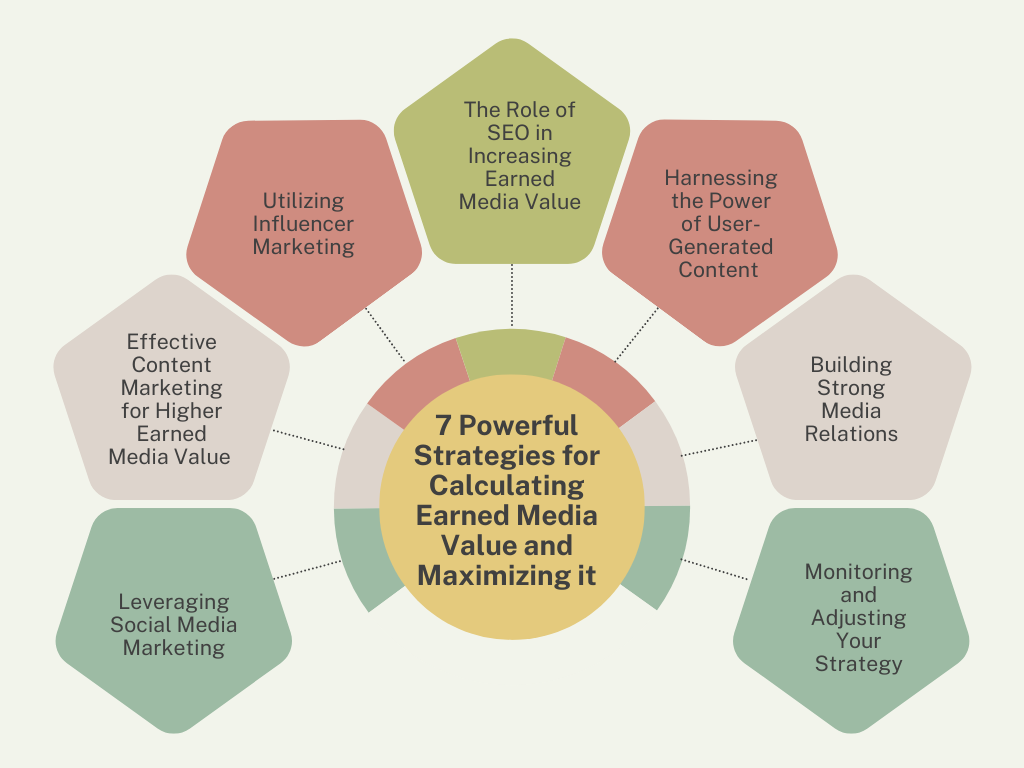
Leveraging Social Media Marketing
Earned media value can be significantly enhanced by appropriately leveraging social media marketing. This involves creating engaging and shareable content across various platforms such as Facebook, Twitter, Instagram, and LinkedIn. A well-optimized social media strategy can generate organic conversations about your brand, subsequently driving higher earned media value.
For instance, the volume of shares, likes, retweets, comments, and followers on your social media platforms can be quantified through a specific formula:
Earned Media Value (EMV) = (Likes + Shares + Comments + Followers) * Engagement Rate
This formula, albeit simple, can give you a ballpark figure on your EMV from social media marketing.
Effective Content Marketing for Higher Earned Media Value
Content marketing is a preventive strategy to increase your earned media value. By creating high-quality, relevant, and SEO-optimized content, brands can attract organic traffic, thereby increasing their web visibility and credibility.
Here, the earned media value is determined by the amount of organic traffic driven to your website or blog. The formula to calculate this could be:
EMV = Organic Traffic * Conversion Rate * Average Order Value
Utilizing Influencer Marketing
Influence marketing plays a critical role in maximizing earned media value. By collaborating with influencers who have substantial followers, brands can enlarge their reach, boost their credibility, and stimulate engagement.
The formula to calculate EMV through influencer marketing could be:
EMV = (Number of Followers * Engagement Rate * Conversion Rate) / Cost per Impression
The Role of SEO in Increasing Earned Media Value
Search Engine Optimization (SEO) is a vital tool for enhancing your earned media value. By optimizing your content with relevant keywords (like “calculating earned media value”), brands can improve their search engine ranking, thereby increasing their visibility and earned media value.
EMV = Organic Traffic * Click Through Rate (CTR) * Conversion Rate
Harnessing the Power of User-Generated Content
User-generated content (UGC) is a powerful tool to increase your brand’s earned media value. Encouraging users to share their experiences with your brand can generate organic conversations and engagement.
EMV = UGC * Engagement Rate * Conversion Rate
Building Strong Media Relations
Building strong relationships with media can significantly boost your earned media value. This can be achieved by consistently providing them with unique, newsworthy content that they can share with their audience.
EMV = Media Impressions * Ad Equivalency Value
Monitoring and Adjusting Your Strategy
Continuous monitoring and adjustment of your strategy are key to maximizing earned media value. Use analytics tools to track your performance, identify areas of improvement, and make necessary adjustments.
EMV = Total EMV (From all strategies) / Number of Strategies
Each of these strategies, when implemented effectively, can significantly increase your earned media value. The key is to continuously monitor, adjust, and optimize each strategy based on performance metrics
Samrat is a Delhi-based MBA from the Indian Institute of Management. He is a Strategy, AI, and Marketing Enthusiast and passionately writes about core and emerging topics in Management studies. Reach out to his LinkedIn for a discussion or follow his Quora Page

